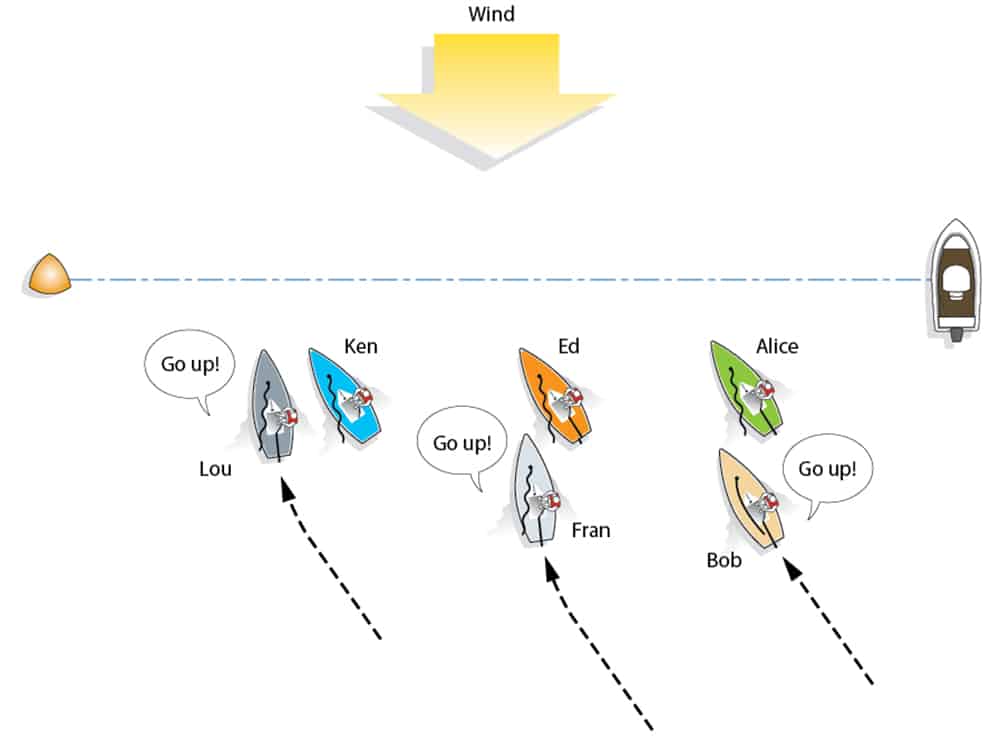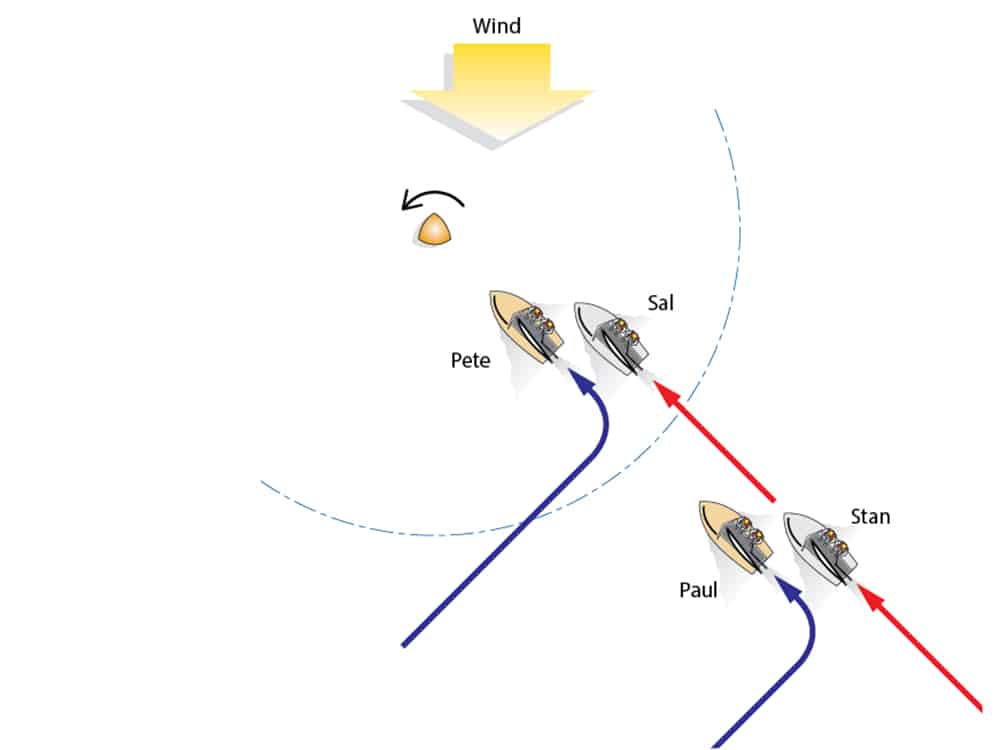Andrew Nelson, youth sailing director for Washington and Oregon, is employed by the Sailing Foundation, a nonprofit whose mission includes increasing the number of kids racing sailboats and raising their skill level. His job gives him an opportunity to see hundreds of youth races each year. He shared with me rule violations he commonly observes.

Luffing in the Prestart
Before the start, while starboard-tack boats are stalled, with sails luffing just below the line, boats that come into that lineup from clear astern with speed don’t seem to understand their rights and obligations. While they are clear astern, they are required by Rule 12 to keep clear of a “parked” boat ahead. Immediately after a leeward overlap begins, the new leeward boats become the right-of-way boats under Rule 11, but they also have two obligations. Under Rule 15, they must initially give the windward boat room to fulfill its new obligation to keep clear, and under Rule 16.1, if they change course, they must give the windward boat room to keep clear.
In the first diagram, just after Bob becomes overlapped with Alice, he holds his course and hails “Go up!” to Alice. But she is not required to go up. Her only obligation is to keep clear, and Bob must give her room to do so.
Fran luffs right after she establishes her overlap on Ed and hails “Go up!” To keep clear, Ed will have to luff, but if he does, his stern will swing into Fran’s bow. If he doesn’t luff, or if he bears away, Fran will have to take avoiding action to keep from having her bow hit Ed’s starboard side. Thus, there’s no way that Ed can keep clear after Fran luffs. Fran’s luff, therefore, breaks Rule 16.1 because when she luffs she does not give Ed room to keep clear. Because she luffs immediately after gaining right of way, she also breaks Rule 15.
A boat’s hull pivots about its centerboard when it turns. Therefore, if a leeward boat luffs before it is bow even with the windward boat, there is likely to be contact. However, if the two boats are bow even or if the leeward boat is bow out, then the windward boat will be able to luff to keep clear. Lou handles this starting-line situation appropriately. Because he delays his luff until he is bow even with Ken, Ken can easily luff and keep clear, so Lou does not break either Rule 15 or 16.1.

Tacking in the Zone
Almost all dinghy races these days begin with a beat to windward to a mark to be left to port. That windward mark is another place where rule violations often occur. In the second diagram, Pete enters the zone on port tack and tacks to leeward of Sal who has been fetching the mark on starboard tack for several lengths. Every boat must eventually tack from port to starboard into a position from which it can fetch the mark. What newcomers to racing don’t appreciate is how easy it is to break a rule if you make that final tack inside the zone.
When Pete tacks, he must comply with three rules. (1) While he and Sal are on opposite tacks, he is on port tack and required by Rule 10 to keep clear. (2) After Pete passes head to wind during his tack, Rule 13 requires him to keep clear of Sal until he is on a closehauled course on starboard, and (3) if he causes Sal to sail above closehauled, he will break Rule 18.3. After Pete completes his tack, he is fetching the mark, but to do so he must luff above closehauled and “shoot” the mark. That luff will cause Sal to sail above closehauled. There is simply no way that Pete could tack where he did and then round the mark without breaking Rule 18.3.
Now let’s see how the rules treat Paul, who tacked onto starboard to leeward of Stan, but did so outside the zone. Rules 10 and 13 apply to Paul just as they did to Pete. But because Paul passes head to wind outside the zone, Rule 18.3 does not apply to him. After Paul tacks, he may luff to shoot the mark even if he causes Stan to sail above closehauled.
There is one additional advantage to making your final tack from port to starboard outside the zone. When boats tack onto starboard more than three lengths from the mark, most of them are overstood. This means that, if you tack close to leeward of one of them, you will probably fetch the mark yourself. If, however, you make that tack in the zone, odds are the boat you tack under will have already cracked its sheets and will no longer be overstanding the mark.
Keeping Clear
On downwind legs, Nelson reports that boats frequently break Rule 15 and then Rule 16.1. This occurs when two port-tack boats are overlapped and close to each other. The windward port-tack boat breaks Rule 15 by jibing onto starboard so close to the leeward port-tack boat that there isn’t room for the port-tack boat to keep clear. What’s more, the jibing boat often makes things worse by immediately luffing and, thereby, breaking Rule 16.1.
All the violations discussed so far suggest coaches and instructors should spend more time on two definitions — “keep clear” and “room,” on the limitations imposed by Rules 15 and 16.1, and on the risks of tacking from port to starboard inside the zone at a windward mark.
Taking Penalties
Nelson reports that collisions resulting in damaged boats are uncommon, indicating that new sailors seem to understand Rule 14’s requirement that boats avoid contact. He also sees quite a few boats making two penalty turns, each including a tack and a jibe, after they are involved in an incident in which a rule of Part 2 may have been broken. However, the turns they take frequently do not meet two requirements of Rule 44.2 — that before beginning to spin, a boat must sail “well clear of other boats as soon after the incident as possible” and then make the two turns “promptly.” When asked why they delay their turns, new sailors often report that they were waiting for the perfect time to spin or that they thought it was OK to delay spinning provided they completed their penalty turns on the same leg they were on when the incident occurred.
The late spinners don’t seem to realize that late turns simply don’t count. If they were protested, they would be disqualified by the protest committee even though they had spun. This suggests that coaches should teach the details of Rule 44.2 and run drills to practice taking a two-turns penalty as quickly as possible.
Another common misunderstanding of penalties taken on the water is this: Sailors who take a two-turns penalty as required by Rule 44.2 often report that they did so because they didn’t know they’d broken a rule. They didn’t realize that in that case they had a get-out-of-jail-free card. That is, they could protest the other boat without risk of disqualification and then learn in the hearing how the rules applied to the incident. If the protest committee found they’d broken a rule, they would not be disqualified because they’d taken the appropriate penalty on the water.
Email for Dick Rose may be sent to rules@sailingworld.com.









